Exhibiting Experimental Art in China
by Wu Hung
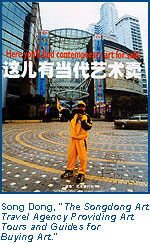
 hinese artists and art critics have been increasingly using the term "experimental art" (shiyan meishu) for its looser and broader implications. They have found terms like "unofficial art" and "avant-garde art" misleading: the former exaggerates the political orientation of this art and the latter exaggerates its artistic radicalism. An artistic experiment, in their view, can be about almost anything related to art and can be something major or something minor. In fact, experimental art is not associated with any particular artistic style, subject matter, or political orientation, but is defined by its relationship with four other major traditions in contemporary Chinese art, namely, (1) a highly politicized official art directly under the sponsorship of the party, (2) an academic art that struggles to separate itself from political propaganda by emphasizing technical training and higher aesthetic standards, (3) a popular urban visual culture that eagerly absorbs fashionable images from Hong Kong, Japan, and the West, and (4) an "international" commercial art, that, though often initially part of experimental art, eventually caters to an international art market. An art experiment in China is always motivated by the desire to break away from the visual modes and vocabulary of these four traditions, though the focus of experimentation may be an art medium or style, new ways of presenting art to the audience, or even the identity and social function of the artist him/herself. During the 20 years since its emergence, the content of Chinese experimental art has been constantly changing as its relationship with these other art traditions changes. Generally speaking, this art has shown three consistent characteristics: a penchant for new art forms and materials, an interest in reinventing the language of artistic expression, and the self-positioning of the artist outside, or on the border of, official and academic art.
hinese artists and art critics have been increasingly using the term "experimental art" (shiyan meishu) for its looser and broader implications. They have found terms like "unofficial art" and "avant-garde art" misleading: the former exaggerates the political orientation of this art and the latter exaggerates its artistic radicalism. An artistic experiment, in their view, can be about almost anything related to art and can be something major or something minor. In fact, experimental art is not associated with any particular artistic style, subject matter, or political orientation, but is defined by its relationship with four other major traditions in contemporary Chinese art, namely, (1) a highly politicized official art directly under the sponsorship of the party, (2) an academic art that struggles to separate itself from political propaganda by emphasizing technical training and higher aesthetic standards, (3) a popular urban visual culture that eagerly absorbs fashionable images from Hong Kong, Japan, and the West, and (4) an "international" commercial art, that, though often initially part of experimental art, eventually caters to an international art market. An art experiment in China is always motivated by the desire to break away from the visual modes and vocabulary of these four traditions, though the focus of experimentation may be an art medium or style, new ways of presenting art to the audience, or even the identity and social function of the artist him/herself. During the 20 years since its emergence, the content of Chinese experimental art has been constantly changing as its relationship with these other art traditions changes. Generally speaking, this art has shown three consistent characteristics: a penchant for new art forms and materials, an interest in reinventing the language of artistic expression, and the self-positioning of the artist outside, or on the border of, official and academic art.
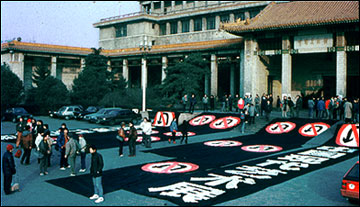
The National Art Gallery, Beijing, on the opening day of the China/Avant-garde exhibition. February 5, 1989.
Once I began my investigation I found no difficulty reconnecting with Beijing's experimental art circle: through earlier dealings I had gotten to know many of its members who then introduced me to some new faces. For the next several months I regularly visited art galleries and artists' studios, attended the openings of large and small shows, participated in seminars organized by Chinese art critics and talked to individual artists about their present and future projects. I was impressed by some works I saw, but never to the extent of proposing an exhibition or writing a book about them. Eventually I realized that my shortage of enthusiasm may in fact reflect a lack of excitement on the part of Chinese artists about their own works at this moment. The once-novel art forms that excited artists in previous years, such as installation, performance video, and computer art, are now widely used. The large-scale demolition and construction in Chinese cities, a phenomenon that had inspired many artists to create original works, had slowed considerably. The open "wounds" of the cities have largely healed; the memory of demolished houses has gradually faded. It is true that Li Xianting, arguably the most influential critic and curator of experimental art in China, has tried to promote at least two "new trends" over the past few years: the first is a Chinese kitsch he calls yansu (translated as "gaudy art"), and the second is an "injury" (shanghai) art whose materials include living animals and human corpses. Both attempts have received mixed reactions, however the latter has in particular divided Chinese artists and critics into antagonistic camps.
Yet, as I stayed longer in China, I became aware of a different issue that transcends such antagonism and even artists' divergent stylistic orientations: how to exhibit experimental art publicly. Without organized efforts or conscious promotion, this issue has attracted many experimental artists, art critics, and independent curators, and has brought them into linked activities and discussions. I call this issue "different" because its focus is not "art" per se; it is not concerned with a new art medium, style, or subject, nor is it associated with any particular artistic school or trend. But once I looked into this issue, it became clear to me that concerns related to it are all crucial to a proper understanding of experimental art in present-day China. These concerns include the relationship between experimental artists and society at large, the public role of experimental art, and how to normalize and legalize this art. It is true that some artists still favor "closed shows" as private communications among themselves; but the dominant choice in 1999 and 2000 has been "to go public." Advocates of this approach hope that by finding new channels to bring experimental art into the public sphere they can undermine the prohibitions imposed by the government upon this art. They further hope that these new channels will eventually constitute a social basis for legitimizing experimental art, so that this art also can contribute to China's ongoing social transformation.
Exhibitions of experimental art since 1979
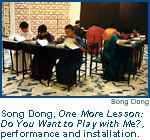 To understand the "experimental" nature of many exhibitions organized since the mid-1990s, we need to briefly review the history of experimental art exhibitions in China since the late 1970s. We can divide the years between 1979 and 2000 into three periods. The first period, represented by the exhibitions of the Stars group in 1979 and 1980 marked the beginning of public exhibitions of experimental art in post-Cultural Revolution China. Most members of the group received no formal art training and were not affiliated with any official art institution. The group's early activities included private discussion sessions and informal art shows. Its members made a breakthrough by exhibiting their works on the street outside Beijing's National Art Gallery in September 1979. A big crowd gathered. Police interfered and canceled the exhibition two days later. The Stars responded by holding a public demonstration on October 1, the thirtieth anniversary of the People's Republic of China.
To understand the "experimental" nature of many exhibitions organized since the mid-1990s, we need to briefly review the history of experimental art exhibitions in China since the late 1970s. We can divide the years between 1979 and 2000 into three periods. The first period, represented by the exhibitions of the Stars group in 1979 and 1980 marked the beginning of public exhibitions of experimental art in post-Cultural Revolution China. Most members of the group received no formal art training and were not affiliated with any official art institution. The group's early activities included private discussion sessions and informal art shows. Its members made a breakthrough by exhibiting their works on the street outside Beijing's National Art Gallery in September 1979. A big crowd gathered. Police interfered and canceled the exhibition two days later. The Stars responded by holding a public demonstration on October 1, the thirtieth anniversary of the People's Republic of China.
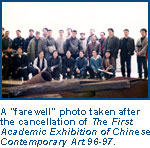 Going one step further, the group hoped to take over an official exhibition space. A year later this hope was partially realized: supported by some open-minded art critics in the semiofficial Chinese Artists' Association, the Third Stars Art Exhibition was held on an upper floor in the National Art Gallery. More than 80,000 people attended the show over a period of 16 days. From the very beginning, therefore, Chinese experimental art showed a strong tendency to expand into the public sphere and to participate in social movements. But in the case of the Stars, a public sphere was narrowly defined as a "political space"--the National Art Gallery. Members of the group followed a mass movement action called duo-quan--"taking over an official institution"--derived from the Cultural Revolution itself. Although the Third Stars Art Exhibition was the first experimental art exhibition held in the National Art Gallery, its impact on the official system of art exhibition was as brief as the show itself. This triumphant moment of the Stars was followed by a 10-year-long absence of experimental art in the National Art Gallery, which ended when the enormous China/Avant-garde exhibition took over this official space in 1989.
Going one step further, the group hoped to take over an official exhibition space. A year later this hope was partially realized: supported by some open-minded art critics in the semiofficial Chinese Artists' Association, the Third Stars Art Exhibition was held on an upper floor in the National Art Gallery. More than 80,000 people attended the show over a period of 16 days. From the very beginning, therefore, Chinese experimental art showed a strong tendency to expand into the public sphere and to participate in social movements. But in the case of the Stars, a public sphere was narrowly defined as a "political space"--the National Art Gallery. Members of the group followed a mass movement action called duo-quan--"taking over an official institution"--derived from the Cultural Revolution itself. Although the Third Stars Art Exhibition was the first experimental art exhibition held in the National Art Gallery, its impact on the official system of art exhibition was as brief as the show itself. This triumphant moment of the Stars was followed by a 10-year-long absence of experimental art in the National Art Gallery, which ended when the enormous China/Avant-garde exhibition took over this official space in 1989.
This 1989 exhibition concluded the second period in the history of experimental art exhibitions. During this period, the Stars' precedent was followed by a nationwide movement of experimental art that emerged around the mid-1980s. Known as the '85 Art New Wave, this movement involved a large number of individual artists in different cities and provinces. These artists formed many "avant-garde" art groups and societies, experimenting with art forms and concepts that they had just learned from the West. The large number and variety of exhibitions and public performances distinguished this period from the previous one. Experimental art exhibitions were organized in all sorts of places, from a classroom in an art school to open ground in a park The organizers made little effort to develop these spaces into regular channels of exhibiting experimental art, however. Rather, many of them were still preoccupied with the idea of taking over official art galleries through an organized movement.
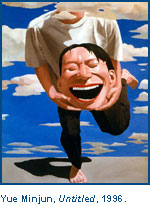 This approach was especially favored by the leaders of the '85 Art New Wave. In an effort to bring scattered groups into a nationwide movement, they proposed as early as 1986 to hold a national exhibition of experimental art in Beijing. They finally realized this plan three years later in the China/Avant-garde exhibition. Without compromising the seminal importance of this exhibition in the history of contemporary Chinese art, it is also necessary to recognize its limitations. First, although it included many works that were radical and even shocking, the notion of a comprehensive, "national" exhibition was traditional and, ironically, found its immediate origin in the official National Art Exhibitions. Second, although organizers gave much thought to the exhibition's location, they offered little discussion about how to change the entire system of art exhibition in China. The 1989 exhibition was envisioned as a grand but temporary event--another triumphant moment of "taking over" a primary official art institution. The National Art Gallery was transformed upon the opening of the exhibition: long black carpets, extending from the street to the entrance of the exhibition hall, bore the emblem of the exhibition--a "No U-Turn" traffic sign signaling "There is no turning back." Many "accidents" during the exhibition, including a premeditated shooting performance and the subsequent police intervention, made a big stir in the capital. The dramatic activism and sense of happening associated with this exhibition closely paralleled the political situation of the time: a heightening pro-democracy movement was preparing itself for a major confrontation with the hard-liners in the government. Three months after the exhibition, many of its organizers and artists participated in the demonstrations in Tiananmen Square, which ended in bloodshed on June 4, 1989.
This approach was especially favored by the leaders of the '85 Art New Wave. In an effort to bring scattered groups into a nationwide movement, they proposed as early as 1986 to hold a national exhibition of experimental art in Beijing. They finally realized this plan three years later in the China/Avant-garde exhibition. Without compromising the seminal importance of this exhibition in the history of contemporary Chinese art, it is also necessary to recognize its limitations. First, although it included many works that were radical and even shocking, the notion of a comprehensive, "national" exhibition was traditional and, ironically, found its immediate origin in the official National Art Exhibitions. Second, although organizers gave much thought to the exhibition's location, they offered little discussion about how to change the entire system of art exhibition in China. The 1989 exhibition was envisioned as a grand but temporary event--another triumphant moment of "taking over" a primary official art institution. The National Art Gallery was transformed upon the opening of the exhibition: long black carpets, extending from the street to the entrance of the exhibition hall, bore the emblem of the exhibition--a "No U-Turn" traffic sign signaling "There is no turning back." Many "accidents" during the exhibition, including a premeditated shooting performance and the subsequent police intervention, made a big stir in the capital. The dramatic activism and sense of happening associated with this exhibition closely paralleled the political situation of the time: a heightening pro-democracy movement was preparing itself for a major confrontation with the hard-liners in the government. Three months after the exhibition, many of its organizers and artists participated in the demonstrations in Tiananmen Square, which ended in bloodshed on June 4, 1989.
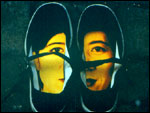
Yin Xiuzhen, Yin Xiuzhen, 1998, mixed-media installation, dimensions variable.
The third period in the history of experimental art exhibitions started in the early 1990s. A fundamental development of Chinese experimental art from the early 1990s up till the present has been a shift from a collective movement to individualized experiments. These experiments are not limited to art media and styles, but are concerned also with the forms and roles of exhibitions. These concerns reflect a new direction of Chinese experimental art toward normalization and systematization. Instead of pursuing a social revolution, curators and artists have become more interested in building a social foundation which would guarantee regular exhibitions of experimental art and reduce interference from the political authorities. A number of new factors in Chinese art have encouraged this interest; these include (1) the deepening globalization of Chinese experimental art, (2) a crisis in the official exhibition system and the government's aggressive response, (3) the appearance of new types of exhibition space as a consequence of China's socioeconomic transformation, and (4) the emergence of independent curators and their growing influence on the development of experimental art. These factors all interact, generating new kinds of exhibitions planned to expand existing exhibition spaces and to forge new exhibition channels. Because such exhibitions are, to a large degree, social experiments, and because their results are still to be seen, I call them "experimental exhibitions."
Stimuli of "experimental exhibitions"
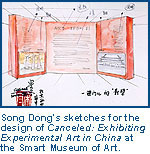 Chinese experimental art was "discovered" in the early 1990s by curators and dealers in Hong Kong, Taiwan, and the West. A series of events, including the world tour of the China's New Art, Post-1989 exhibition organized by Hong Kong's Hanart T Z Gallery, the appearance of young Chinese experimental artists in the 1993 Venice Biennale, and cover articles in Flash Art and the New York Times Magazine, introduced this art to a global audience. Since then, Chinese experimental art has attracted growing attention abroad. To list just a few recent events: at least two large exhibitions of this art took place in the United States in 1999; Beijing-born artist Xu Bing was awarded a MacArthur Fellowship in the same year; the work of another New York-based Chinese artist, Gu Wenda, was featured on the cover of Art in America; twenty Chinese artists were selected to present their work in the 1999 Venice Biennale, more than the number of either the American or Italian participants; Cai Guoqiang won one of three International Awards granted at this Biennale. While Xu Bing, Gu Wenda, and Cai Guoqiang are among those Chinese artists who have emigrated to the West and established their reputations there, artists who have decided to remain home find no shortage of invitations to international exhibitions and art fairs. Their works are covered by foreign media and appear regularly in books and magazines.
Chinese experimental art was "discovered" in the early 1990s by curators and dealers in Hong Kong, Taiwan, and the West. A series of events, including the world tour of the China's New Art, Post-1989 exhibition organized by Hong Kong's Hanart T Z Gallery, the appearance of young Chinese experimental artists in the 1993 Venice Biennale, and cover articles in Flash Art and the New York Times Magazine, introduced this art to a global audience. Since then, Chinese experimental art has attracted growing attention abroad. To list just a few recent events: at least two large exhibitions of this art took place in the United States in 1999; Beijing-born artist Xu Bing was awarded a MacArthur Fellowship in the same year; the work of another New York-based Chinese artist, Gu Wenda, was featured on the cover of Art in America; twenty Chinese artists were selected to present their work in the 1999 Venice Biennale, more than the number of either the American or Italian participants; Cai Guoqiang won one of three International Awards granted at this Biennale. While Xu Bing, Gu Wenda, and Cai Guoqiang are among those Chinese artists who have emigrated to the West and established their reputations there, artists who have decided to remain home find no shortage of invitations to international exhibitions and art fairs. Their works are covered by foreign media and appear regularly in books and magazines.
Many artists in this second group are "independent" in status, meaning that they are not associated with any official art institution and often have no steady employment. This lifestyle has become prevalent among experimental artists since the early 1990s, and has allowed them to go back and forth between China and other countries. (Interestingly, the Chinese government has rarely rejected their applications for travel visas, at least during the past seven or eight years.) A parallel phenomenon in the '90s was the appearance of "independent curators" (duli cezhanren). Usually not employed by official or commercial galleries, these individuals organize exhibitions of experimental art primarily out of personal interest. They are not normally full-time curators: some of them are art critics and editors while others are artists themselves. In either case, they keep close relationships with experimental artists and introduce them to a larger audience through exhibitions and writings.
Experimental artists and independent curators are playing an increasingly important role in contemporary Chinese art because of their familiarity with the international art scene--not just with a few fashionable names and styles but, more importantly, with standardized art practices and with various types of exhibitions and exhibition spaces. They are, in fact, members of a global art community, but they identify themselves with "Chinese art" and decide to act locally.
A key to understanding these independent artists and curators--many of whom seem to be thoroughly Westernized--is their deep bond with China. They believe their work is part of contemporary Chinese culture and must be inspired by Chinese realities. Ironically, this self-realization has been encouraged by frequent participation in international exhibitions. If a decade ago an invitation to a major international exhibition was an exceptional event, such invitations are no longer rarities. While still traveling abroad, some artists have begun to question whether such exposure has any real significance. Many experimental artists have also become increasingly critical toward foreign curators, accusing them of coming to China to "pick" works to support their own views of China and
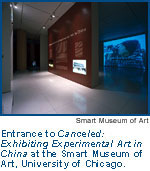 Chinese art, which the artists see as a typical Orientalist or postcolonial practice. This criticism is shared by many independent curators. It then becomes natural for these curators and artists to launch indigenous exhibitions facilitated by their familiarity with Western shows. But here they run into another problem.
Chinese art, which the artists see as a typical Orientalist or postcolonial practice. This criticism is shared by many independent curators. It then becomes natural for these curators and artists to launch indigenous exhibitions facilitated by their familiarity with Western shows. But here they run into another problem.
In sharp contrast to its popularity among foreign curators and collectors, Chinese experimental art is still struggling, to say the least, for basic acceptance at home. Although books and magazines about avant-garde art are readily available in bookstores, actual exhibitions, especially those involving performances, installation, video, and computer art are still generally discouraged by the official establishment, including state-run art galleries and schools. There has been, in fact, a tighter control over such exhibitions in the past two to three years; the result has been the cancellation and early termination of at least 10 exhibitions of experimental art in Beijing alone, including five large shows each featuring 20 to 40 artists.
The reasons behind these cancellations and early terminations are complex. One main reason is the government's frustration in seeing its control over the art world slip. As the cadres in the Ministry of Cultural Affairs and the Ministry of Propaganda face growing difficulties stopping the flow of information about Western art and ideas, and as they find their own exhibitions attracting fewer and fewer people, they react aggressively to tighten their grasp over those areas they believe are still under their control. Art exhibitions are one such area. According to a government regulation, all public art exhibitions must be organized (zhuban) by institutions entitled to organize such exhibitions, and all public art exhibitions must be held in registered exhibition spaces and be approved by responsible authorities. This regulation gives the government and its agencies--the Department of Cultural Affairs or the police--almost unlimited power to turn down any proposed exhibition or to close down any exhibition that has already been installed or even opened: innumerable reasons, from an incomplete approval procedure to an inappropriate exhibition space, can be used to justify such actions.
 Any independent curator who plans to organize an exhibition of experimental art must face this stern reality. On the other hand, the fact that so many exhibitions of experimental art, including some showing radical or extreme works, have taken place over the past decade proves that government regulation only represents part of reality; there is room for courageous and smart curators to explore. Starting in 1994 and especially after 1997, many exhibitions have indicated a new direction: these curators are no longer satisfied with finding any available space--even a primary space such as the National Art Gallery--to put on an exhibition. Rather, many of them have organized exhibitions for a larger purpose: to create regular exhibition channels and to "legalize" experimental art. To these curators, it is now possible to pursue these goals because of new conditions in their country. They believe that China's socioeconomic transformation has created and continues to create new social sectors and spaces that can be exploited for developing experimental art.
Any independent curator who plans to organize an exhibition of experimental art must face this stern reality. On the other hand, the fact that so many exhibitions of experimental art, including some showing radical or extreme works, have taken place over the past decade proves that government regulation only represents part of reality; there is room for courageous and smart curators to explore. Starting in 1994 and especially after 1997, many exhibitions have indicated a new direction: these curators are no longer satisfied with finding any available space--even a primary space such as the National Art Gallery--to put on an exhibition. Rather, many of them have organized exhibitions for a larger purpose: to create regular exhibition channels and to "legalize" experimental art. To these curators, it is now possible to pursue these goals because of new conditions in their country. They believe that China's socioeconomic transformation has created and continues to create new social sectors and spaces that can be exploited for developing experimental art.
ABOUT THE AUTHOR |
Wu Hung
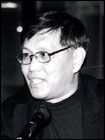
Wu Hung grew up in Beijing and received his B.A. and M.A. in art history from the Central Academy of fine arts in Beijing. From 1973 to 1978 he served on the research staff at the Palace Museum, located inside Beijing's Forbidden City.
He came to the United States in 1980 and obtained his Ph.D. in art history and anthropology from Harvard University in 1987. That same year he began to teach art history at Harvard and was promoted to full professor in 1994. He then moved to the University of Chicago, where he is now the Harrie A. Vanderstappen Distinguished Service Professor in Chinese Art History. Although best known as a scholar of ancient Chinese art, he has always had an intense interest in contemporary Chinese art and has contributed significantly to the introduction of this art to the American public. In the mid-eighties he organized a series of exhibitions of contemporary Chinese art at Adams House, Harvard University, which included the American debuts of important artists including Chen Danqing, Luo Zhongji, Mu Xin, Qiu Deshu, and Zhang Hongtu. He has published articles on contemporary Chinese art and visual culture in various journals and has contributed to numerous exhibition catalogues.
Wu Hung's writings have received a number of important awards. The Wu Liang Shrine: The Ideology of Early Chinese Pictorial Art (Stanford, 1989) won the Association for Asian Studies' 1990 Joseph Levenson Prize for best book in Chinese studies (traditional). His coauthored book, Three Thousand Years of Chinese Painting (New Haven and London, 1997), received the Haskin Award from the Association of American Publishers in 1998. Monumentality in Early Chinese Art and Architecture (Stanford, 1995) was selected by Choice as an Outstanding Academic Publication in 1996 and was also nominated in 1999 by Artforum as one of the "Best Books of the 90s."
COPYRIGHT | Excerpted from pages 11-19 of Exhibiting Experimental Art in China by Wu Hung, published by the David and Alfred Smart Museum of Art at the University of Chicago. Copyright 2000 The University of Chicago.